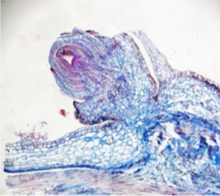This study aimed to develop an efficient micropropagation protocol for Disanthus cercidifolius Maxim., an ornamental shrub. Sprouting buds of two genotypes (‘Trubaʼ and ‘PdSʼ) were used as an initial plant material.
For the in vitro propagation experiment,the nodal segments were cultured on a MS medium supplemented with either N6-benzyladenine (BA) or zeatin (both at 0.5–3 mg l−1). As a control, MS medium without growth regulators was used. The highest number of shoots per explant (6.95 ± 0.33 in genotype ‘PdSʼ and 7.93 ± 0.41 in genotype ‘Trubaʼ) was achieved on a medium supplemented with 2 mg l−1 BA. Half-strength WPM and half-strength MS medium supplemented with indole-3-butyric acid (IBA) (0.1–1 mg l−1) were tested for in vitro rooting of the shoots. Optimal rooting performance was achieved on a half-strength WPM containing 0.5 mg l−1 IBA in genotype ‘PdSʼ, and 0.1 mg l−1 IBA in genotypes ‘Trubaʼ. The rooted plantlets were transferred ex vitro with 85% survival in genotype ‘PdSʼ and 82.5% in genotype ‘Trubaʼ. Eighteen samples from each genotype were subjected to ISSR analysis and flow cytometry to assess plant genetic fidelity after micropropagation. Fifteen ISSR primers gave rise to monomorphic patterns indicating no detected genetic variation in regenerants. Flow cytometric analysis showed that the ploidy level in all tested in vitro regenerants remained stable. The micropropagation protocol optimized here represents a reliable and efficient method for the large-scale production of plants of the ornamental shrub Disanthus cercidifolius.
DOI name
Typ publikace
Periodikum nebo kniha
Datum vydání

